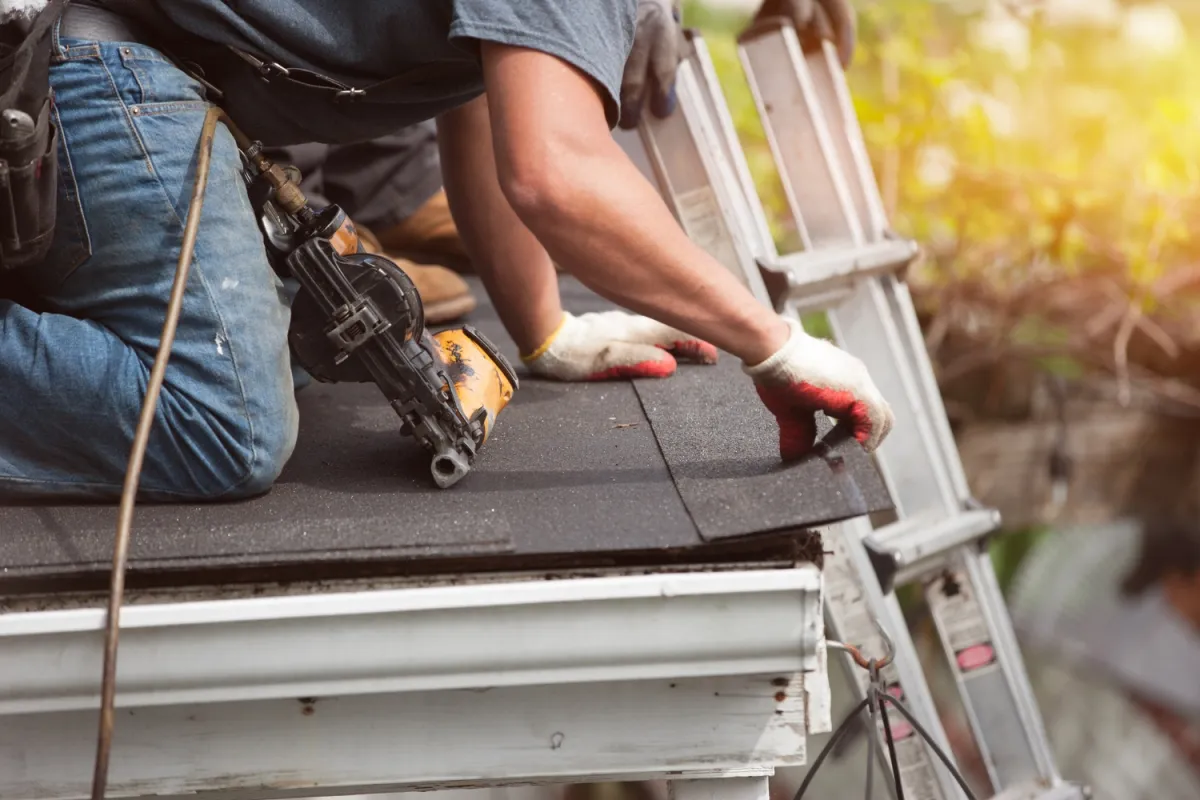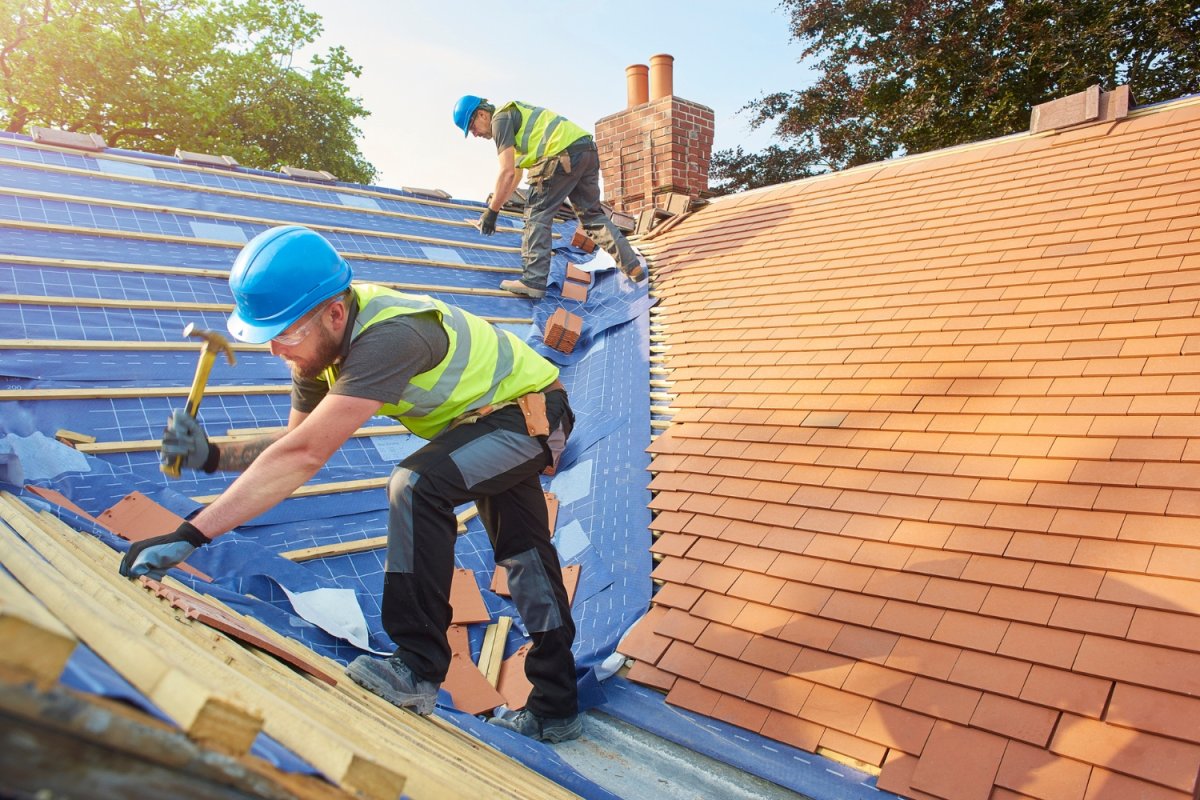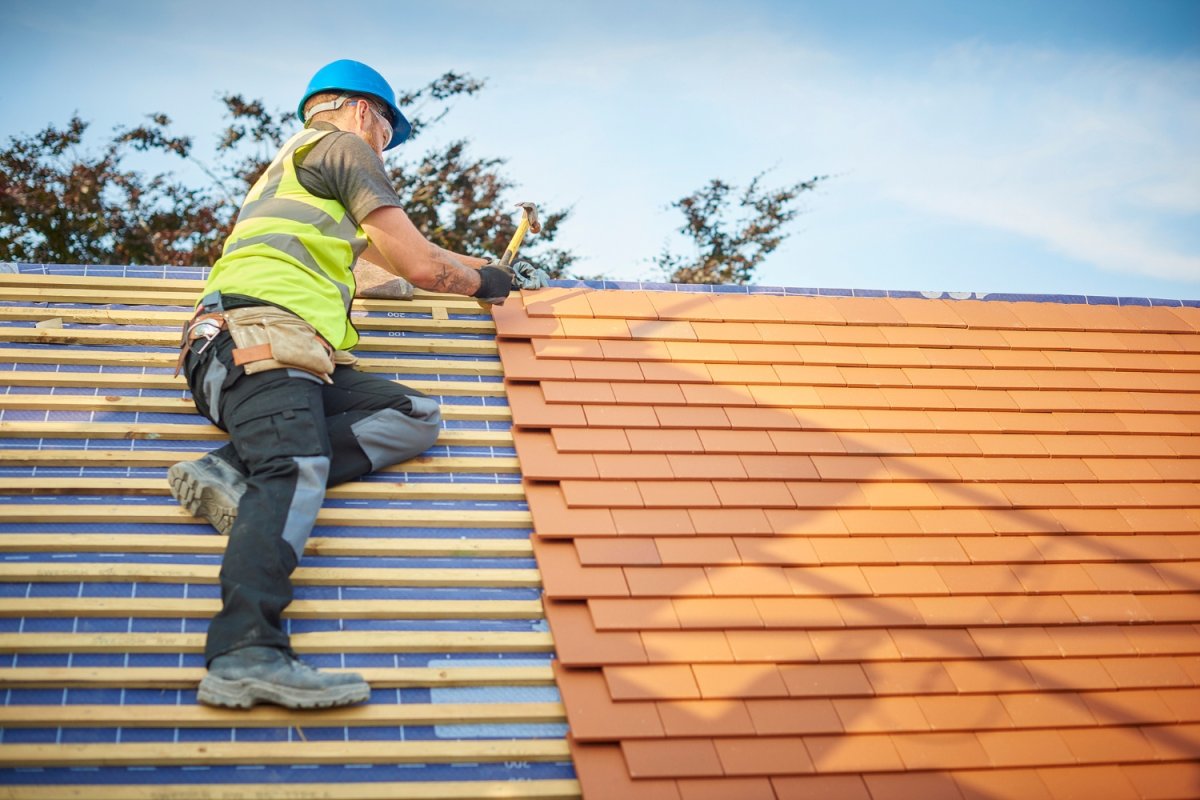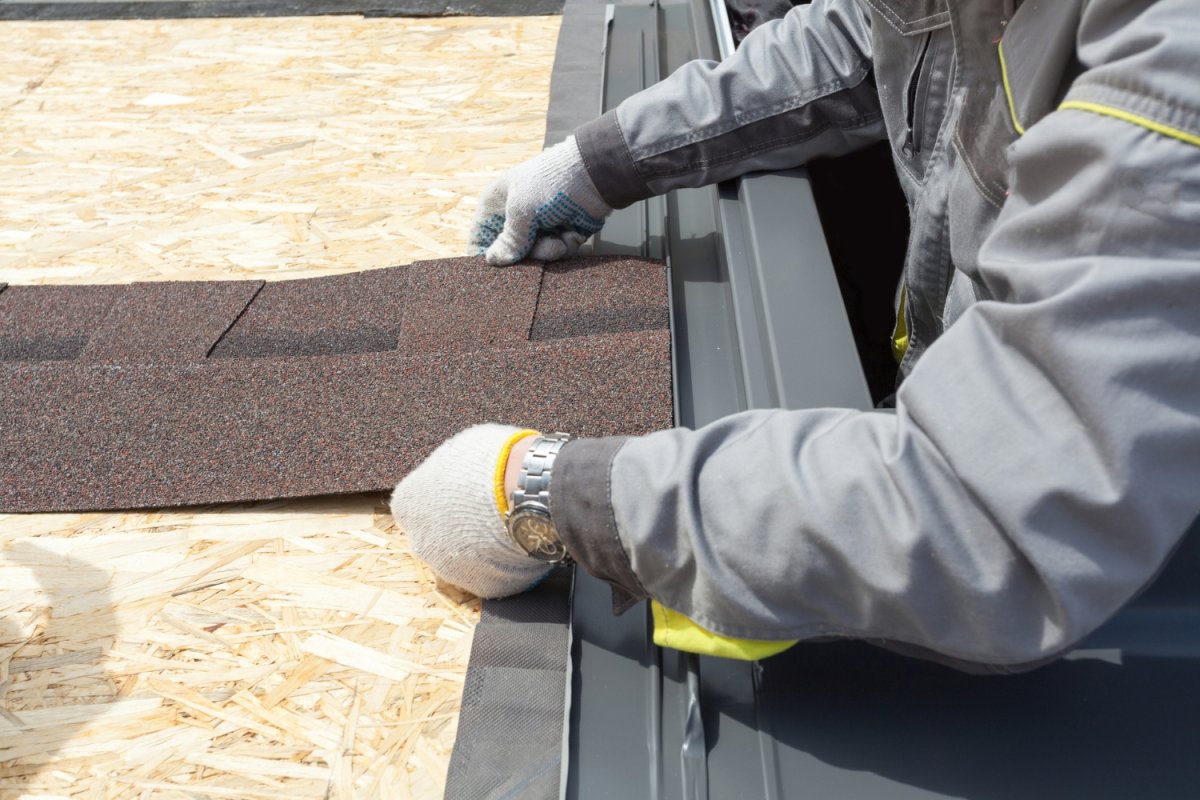We may earn revenue from the products available on this page and participate in affiliate programs. Learn More ›
There’s no question that dealing with roof damage can be a stressful experience. Roof repair and roof replacement costs can quickly spiral out of control, leaving homeowners scrambling for solutions. To minimize the financial burden of a roof replacement, a policy from one of the best homeowners insurance companies (like Allstate or Lemonade) can be a valuable tool.
To understand the intricacies of roof insurance, homeowners will need to research the types of damage typically covered under a homeowners insurance policy. They’ll also want to look into the steps they’ll need to follow to assess the damage, submit a claim, and schedule repairs. Ultimately, homeowners can learn how to get insurance to pay for a roof replacement provided the damage was caused by a covered event.

STEP 1: Check your policy to familiarize yourself on what will and will not be covered.
Homeowners insurance typically covers roof damage and loss of property caused by covered perils, such as hail, wind, lightning, and fire, to name a few. Damage that’s caused by normal wear and tear (such as cracked or missing shingles) will not be covered. However, it’s important to note that the specific types of roof damage covered by home insurance will depend on the individual policy. Examples of potentially covered damage include roof hail damage, windblown debris punctures, and damage caused by fallen tree branches during a storm. To understand the scope of their roof coverage, homeowners will need to review their policy documents or contact their insurance provider directly.
Homeowners who have one of the best home warranties for roof coverage (like one from American Home Shield or Choice Home Warranty) may be able to get roof repairs or replacements covered if the roofing damage was caused by age-related issues that homeowners insurance will not cover.
STEP 2: Assess the damage to the roof and document it with photos and videos.
Documenting the roof damage is one of the most crucial steps. Without visual evidence to back up a claim, homeowners risk the insurance company rejecting their claim, leaving them on their own to pay for their new roof. Once a homeowner has confirmed that their home insurance policy will cover their roof damage, assessing the severity of the problem is the next step. Of course, safety is a top priority, so homeowners will want to avoid climbing onto their roof unless they have the proper equipment and experience. Instead, professionals recommend conducting a simple visual inspection from the ground or a stabilized ladder. Homeowners can look for dented, missing, or cracked shingles, warping around vents or chimneys, and any obvious signs of water intrusion.
If the roof damage is extensive, homeowners may also need to schedule an inspection with a qualified roofing contractor near them. A pro can provide a professional evaluation and determine if spot repairs can address the issue or whether a full roof replacement is necessary. For home insurance to cover the full replacement, homeowners will need to prove that the damage is so severe that repairs won’t do the trick. To do this, they will need detailed photos and videos of the damage, which a local roofing company can also help with. Although a roof inspection can present an additional out-of-pocket cost, homeowners may be more willing to pay these roof inspection costs if it makes it easier to get their claim approved.

STEP 3: Contact your insurance company to start the claim process.
Once homeowners finish assessing and documenting their roof damage, it’s time to contact their insurance company to begin the claims process. At this stage, the insurance provider will want to collect any relevant information, including details on both the cause and the scope of the damage.
To use their roofing insurance, homeowners will need to be specific about the nature of their situation, noting the date of the incident and detailing the physical characteristics of the damage, especially if said damage is compromising the structural integrity of their home. By giving the insurance company all of these details, homeowners may be able to streamline the claims process, allowing their provider to move forward without delay.
STEP 4: Wait for the insurance adjuster to come to your home and inspect the damage.
Before the insurance company will approve the claim, it will want to send an insurance adjuster to assess the roof damage firsthand. When the adjuster arrives, homeowners will want to be prepared to provide information about their roof damage, such as the date the damage occurred and details on any recent storms in the area.
The insurance adjuster will closely examine the damage to confirm that it was caused by a covered event. For example, hail damage and blistering share a physical resemblance, but an insurance adjuster will be able to tell the difference between the two types of damage. The adjuster will also be able to assess the scope of the damage to estimate roof repair costs. Once they confirm that the damage will be covered under the homeowners insurance policy, the adjuster will use the details they have collected to write up a claim. This will allow homeowners to move forward to the next step in the process.

STEP 5: Look for a reputable roofing contractor.
Once the insurance claim is on track, it’s time for homeowners to find a qualified contractor for their roof replacement. When comparing roofers, homeowners will need to balance cost and credibility. They’ll also need to obtain estimates from multiple local, licensed contractors to find the best fit for both their roof and their budget.
Homeowners will also want to consider reading online reviews from previous customers. These can provide valuable insight into the pricing, quality of work, and overall customer experience provided by each contractor on their list. By choosing one of the best roofing companies (like Aspen Contracting or CMR Construction & Roofing) in their area, homeowners can unlock invaluable peace of mind knowing that their roof replacement will be completed in a timely manner and at the agreed-upon price.
STEP 6: Beware of storm chasers and insurance scams.
If the roofing damage was caused by a major storm, some roofing companies may target the area and go door-to-door promising quick repairs at low prices. This isn’t always a bad thing, but homeowners need to be wary of these offers, as everything may not be as it seems on the surface. Scammers often make promises they won’t keep and run off with the homeowner’s hard-earned cash.
Storm chasers often come from out of state, offering lower prices than what homeowners might find with trusted, local roofing companies. But beware: These storm chasers will likely leave town just as quickly as they arrived, leaving behind less-than-stellar work and disappearing when follow-up repairs are needed. To avoid falling victim to one of these scams, homeowners will want to take their time making a decision, and not feel pressured into an immediate decision. Instead, they will need to do their due diligence to research any roofing company they are considering for the job.

STEP 7: Submit your claim to the insurance company.
After consulting a reputable contractor, homeowners will need to submit to their insurance company everything they have collected so the company can make a final decision on their claim. When using roof replacement insurance, homeowners will need to be prepared to be patient. The decision can take several days or up to several weeks, depending on the insurance provider.
During this time, the insurance company may request additional paperwork or ask follow-up questions regarding the details of the claim. To get through this step as quickly and easily as possible, homeowners will want to minimize friction with the insurance company by complying with its requests.
Homeowners will want to bear in mind that they will have out-of-pocket costs even when they use their insurance for roof replacement. They will need to pay a portion of the claim, known as a deductible, which could be thousands of dollars. Homeowners can check their policy to see how much their deductible is.
STEP 8: Get your roof replaced.
Once the claim is approved and the contractor is hired, homeowners are finally ready to get their new roof. But before the project can begin, they will need to talk with their contractor to choose a roofing material. Popular options include asphalt shingles, metal roofing, tile, and slate. Each of these materials comes with its own advantages and disadvantages. To choose the best material for their unique needs, homeowners will need to consider the cost, durability, and aesthetic of each and consult their roofer for expert advice.
Once the plan is in motion, the insurance company will typically send the payment directly to the contractor, either as a single sum or in installments, depending on the claim amount. However, if the insurance payout falls short of the total replacement cost, homeowners may need to explore other financing options, such as a home equity loan or line of credit, to cover the difference.
STEP 9: Stay in touch with your insurance agent throughout the process.
As homeowners move through the process of replacing their roof, they will want to stay in close contact with their insurance agent, sharing photos, estimates, and any other relevant information along the way. By keeping their agent informed, homeowners can foster open communication. Their agent may return the favor by keeping them updated throughout the claims process.
When homeowners are using insurance for a roof replacement, the insurance agent will be a valuable resource. They can answer questions, clarify policy details, and help to solve any potential problems that might arise with the roofing contractor. In general, staying in touch with the insurance agent can help homeowners streamline the claims process, ensuring a successful roof replacement.
Whether a roof has sustained damage due to fire, wind, or hail damage, roof repairs can be expensive, but with house insurance, roof replacements may seem more attainable. Still, to successfully navigate the process of getting a roof replaced by insurance, homeowners will need to be prepared to do some waiting. From assessing the damage to submitting the claim, it’s important to remember that using homeowners insurance for a roof replacement can be a lengthy process. Therefore, homeowners will need to be patient and maintain clear, consistent communication with the insurance provider.


